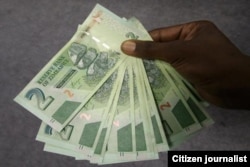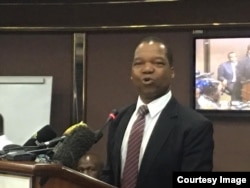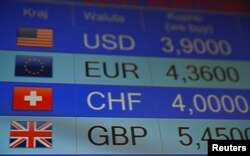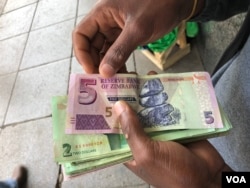Zimbabwe’s troubled quasi-currency bond note, which according to the government was trading at the same rate as the United States dollar, had its peg dumped Wednesday as the country starts establising an inter-bank foreign exchange market in an attempt to control galloping inflation, rising prices of basic commodities and the illegal money market.
In his Monetary Policy Statement delivered Wednesday, central bank governor John Mangudya said the Reserve Bank of Zimbabwe took note of the “excellent contributions from the business community, bankers, the academia, the media and members of the public on the need to establish an inter-bank foreign exchange market to formalise the selling and buying of US$s through banks and bureaux de change.”
Mangudya said this is designed to bring sanity in the foreign currency market while at the same time promoting exports, diaspora remittances and investments for the good of the Zimbabwe economy.
He said the bank considered the implications - accounting, financial, economic, legal and social - that are embedded in the establishment of an inter-bank forex market within the context of the current national payment systems made up of Real Time Gross Settlement (RTGS), mobile payment platforms, point of sale (POS), bond notes and coins.
“After taking account of the implications and putting in place safeguards to maintain stability in the forex market, the Bank is, with immediate effect, establishing an inter-bank foreign exchange market in Zimbabwe to formalise the trading of RTGS balances and bond notes with US$s and other currencies on a willing-buyer willing-seller basis through banks and bureaux de change.”
Mangudya said the operating framework of the inter-bank foreign exchange market includes denominating the existing RTGS balances, bond notes and coins in circulation as RTGS dollars in order to establish an exchange rate between the current monetary balances and foreign currency.
“The RTGS dollars thus become part of the multi-currency system in Zimbabwe. The legal instrument to give effect to this has been prepared. The RTGS dollars shall be used by all entities (including government) and individuals in Zimbabwe for the purposes of pricing of goods and services, record debts, accounting and settlement of domestic transactions. The use of RTGS dollars for domestic transactions will eliminate the existence of the multi-pricing system and charging of goods and services in foreign currency within the domestic economy.”
He said, in this regard, prices should remain “at their current levels and or to start to decline in sympathy with the stability in the exchange rate given that the current monetary balances have not been changed.
“In this respect, the RBZ will commit all its efforts to use the instruments at its disposal to maintain stability of the exchange rate. The Bank has arranged sufficient lines of credit to enable it to maintain adequate foreign currency to underpin the foreign exchange market. This is essential to restore the purchasing power of RTGS balances through safeguarding price stability emanating from the pass-through effects of exchange rate movements. Foreign currency from the inter-bank market shall be utilised for current bonafide foreign payment invoices except for education fees.”
Mangudya said the central bank will tightly monitor the inter-bank market in order to eliminate unfair trading.
“Banks shall report activities of the inter-bank foreign currency market to the Bank that shall closely monitor the foreign currency trades on a daily basis using the form and format stipulated by the Bank. Bureaux de change shall be authorised to purchase foreign currency without limits but shall be limited to sell foreign currency for small transactions such as subscriptions, business and personal travel up to a maximum aggregate daily limit of US$10.000 per bureau de change. Like with banks, bureaux de change and their agents shall report their activities of the inter-bank on a daily basis as required by the Bank.”
He further noted that in order to enhance liquidity within the foreign currency market, exporters shall be entitled to utilise their retained export receipts within 30 days, after which the unutilised export receipts will be offloaded into the market at the prevailing market exchange rate.
“All international remittances and individual funds received from offshore shall continue to be treated as free funds. Local Settlement of Nostro FCA Transfers given the successful completion of the separation of RTGS FCAs and Nostro FCAs, the Bank is, with effect from 25th February 2019, putting in place a local Nostro FCAs settlement platform to allow for domestic inter-bank settlement of Nostro FCA transfers.”
To anchor price stability, Mangudya said the Reserve Bank of Zimbabwe shall aggressively intervene in the market to sterilize liquidity so as to help contain inflationary and exchange rate pressures.
Since the last Monetary Policy Statement in October 2018, Zimbabwe has witnessed significant changes on the economic front. According to the central bank, the economy took a different course of direction from a positive economic trajectory to an inflationary environment.
The foreign exchange premiums on the parallel market which ranged from 1.40 to 1.80 to the US dollar in September 2018 increased to the current levels of between 3.00 to 4.00. This fueled inflation which increased particularly from the September year-on-year level of 5.4% to 20.9% in October and closed the year at 42.09%.
On the positive side, said Mangudya, the separation of bank accounts into NOSTRO FCAs and RTGS FCAs yielded positive results as reflected by the significant increase in the Nostro FCAs to US$451.2 million as at 31st January 2019, compared to US$240.5 million at the beginning of October 2018, a growth of 87.6%.
“The significant shift in economic fundamentals during the last quarter of 2018 also increased the practice by retailers of charging goods and services on the basis of a multi-tier pricing system, where a single product has different prices depending on the mode of payment e.g. USD cash, electronic payment, mobile money and bond notes. This situation has continued to put pressure on the country’s balance of payments position. The current pricing structure indicates that the majority of transactions in the economy are now largely being conducted in electronic money and bond notes at 7 an implied parallel market exchange rate of around 3.0 to 3.5 to the USD.
“In this respect, continuing to use the USD as a unit of account in the economy, when its value has drifted away from the value of the RTGS denominated money supply has brought forth a number of challenges. The challenges include multi-tier pricing by business, speculative pricing, loss of government revenue, valuation and accounting difficulties, asset-liability mismatches and negative investor confidence.”
He noted that the current monetary arrangements, if maintained, could pose the risk of a costly re-dollarisation of the economy which will move the economy into a recession.
“This is evidenced by the fact that some businesses are already gradually reducing prices due to low demand in the economy. Moreover, some of those charging in foreign currency have also been experiencing reduced demand for their products and are, thus, reverting to pricing in RTGS and/or bond notes.”











